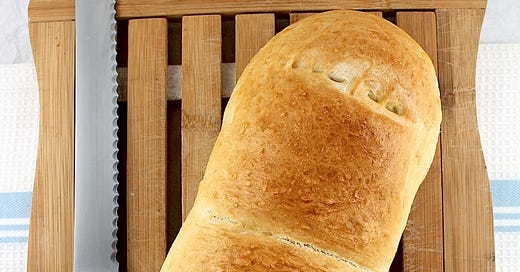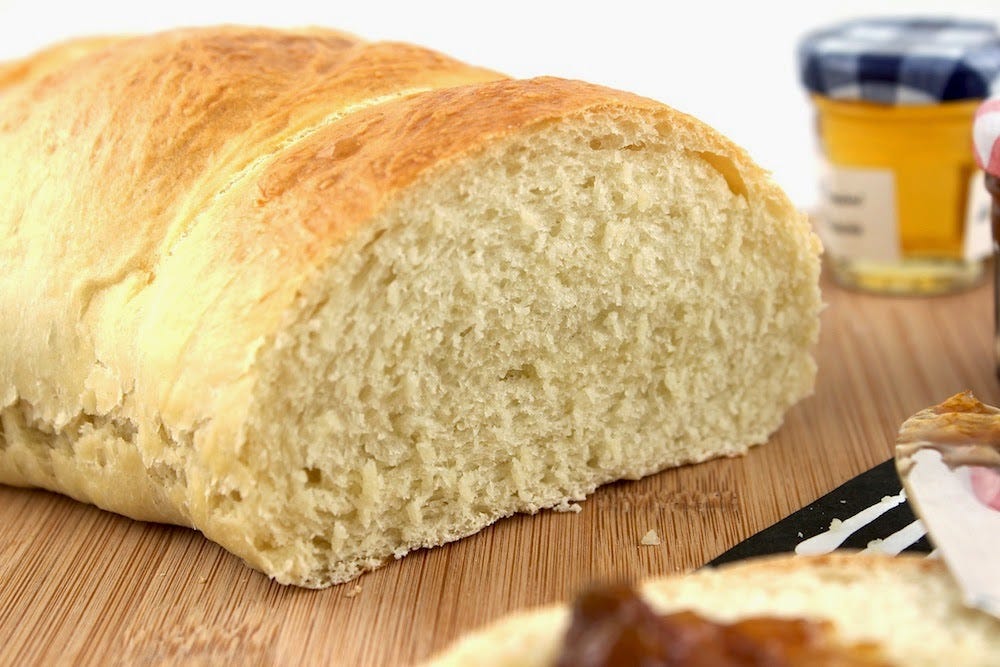“All woes are lighter if there’s bread.”—Miguel de Cervantes
“The most necessary of all foods, which Divine Goodness has created for the maintenance of man's life, is Bread. His blessing extends so far over this food that we are never disgusted by it, and the most precious Meats cannot be eaten without Bread.” So wrote Nicolas de Bonnefons in 1655 in his influential tome Les Délices de la Compagne, explaining why he opens his book with the chapter on bread.
Bread. The staff of life. C'est à la sueur de ton visage que tu mangeras du pain: By the sweat of your brow that you'll eat your bread. Élie Reclus, in his 1909 treatise Le Pain, quoted Genesis to illustrate his thoughts on bread: “Man toils and toils for his daily bread, walks, runs, and hustles, supporting hard work.” Man, in other words, will do anything to have bread.
Revolutions have been started over the lack of flour to make bread. And the scarcity of bread led to innovations in science, technology, and breadmaking to appease the masses. In the great houses and castles of France, the pastry oven was tucked away in a corner of the kitchen, reserved for the family’s use, but bread ovens were out in the courtyard where anyone from the surrounding villages and farms could come bake their own bread. Bread, the grand families understood, was a necessity for everyone.
I’m not here to recount the long, long history of bread. Bread has always been the most basic staple through many cultures across many centuries, a tradition reaching back to antiquity and evolving alongside agricultural, technological, scientific, and gastronomic developments. In his 1905 Dictionnaire Universel de la Cuisine, Joseph Favre claimed that the French word for bread, pain, comes from the Latin panis, itself derived from the Sanskrit pâ, meaning “to nourish.” The idea of bread as nourishment has remained steady throughout history. “La nourriture des forts, du pain qui donne la santé de l’âme,” wrote Madame Dufrénoy in her 1816 book La Petite Ménagère, or “The Little Housewife,” referring to bread as “food for the strong, bread for the healthy soul.”
“Food is simple, or medicinal; the simple nourishes and restores the parts (of the body) and maintains them in the same state; as, for example, bread.” It was a rare thing that Louis Lémery included a prepared food in his book “Traité des Aliments” (“Treatise on Foods”) in 1705, a pioneering work in the field of dietary science and nutrition. He described every possible foodstuff, individual ingredients, fruits, meats, herbs, spices, vegetables, and how each affects the body, but nothing prepared. Except bread. He obviously saw bread as an important foodstuff, one central to man’s diet, one of our most commonly consumed foods. “Bread,” he wrote, “is very nourishing and provides a wholesome food. The crust of roasted bread tightens and its crumb used as a poultice softens, digests, soothes and resolves. Bread only produces bad effects when used excessively, or when poorly made. Bread is suitable for all times, ages and temperaments.”
In a French household, bread (purchased daily) is always on the table—morning, noon, evening, and in between—eaten with every meal and snack. In most French homes and restaurants alike, it’s served plain, without butter: just bread, used to push food onto a fork, to mop up sauces, or to accompany bites of cheese. Bakeries are everywhere. In my small town alone, there are eight boulangeries—not counting the ones inside the three local supermarkets—for a population of just 8,000. There are even a couple of vending machines that dispense freshly baked baguettes: drop in a few coins, like you would for a soda or a bag of chips, and out comes a warm loaf, allowing the locals to have bread even when all the boulangeries are closed.
As much I love to bake, I rarely make bread unless it’s an enriched brioche, fouace, coffee cake, or dough for pizza and focaccia. I don’t have to. But I find that making bread is therapeutic--kneading dough, watching it rise and come to life, magically become deeply golden loaves in the oven as the kitchen fills with the divine fragrance.
But these troubled times—I do keep coming back to our turbulent political landscape, the anxiety, the fear and stress it is causing us—call for both comfort and sustenance. And there is nothing that does both for us, body and soul, quite like bread.
“Bread is such a necessary food that we can't do without it,” wrote Lémery. “We eat almost nothing without bread…. When you have bread, you can do without any other food.”
Well, almost.
Bread is also a food that has a multitude of uses, fresh, yes, but stale, as well. Sandwiches, grilled cheese, or a croque monsieur, French toast (pain perdu, in French, “lost bread” which, of course, is never lost), bread pudding, stuffing, breadcrumbs, croutons for soup or salad, crostini or bruschetta; bread can be transformed into a million different things, so it’s never wasted—an important factor in any food we buy or make these days.
This recipe for a French-style bread is the easiest and most satisfying I’ve made, satisfying both in the process and in the eating. And simple enough for even the novice bread baker or for anyone who has ever wanted or needed to make their own.
“Our baker arrived from Paris; soon, the prince’s table was served with French-style bread, and everyone was happy.”—Marie-Antoine Carême, “Le Pâtissier Royal Parisien,” 1815
Fast and Fabulous French Bread
Makes 3 loaves - so freeze one for later
1 tablespoon (10 grams) powdered or granulated dry yeast
⅓ cup (80 ml) warm (body temperature) water
1 ½ tablespoons granulated white or golden sugar
1 tablespoon salt
1 tablespoon (15 grams) unsalted butter, preferably softened
1 cup (250 ml) boiling water
1 cup (250 ml) cold water
5 - 6 cups all-purpose flour (I use regular French flour, which is soft)
1 egg, lightly beaten
Preheat the oven to 175°F (80°C). (*Yes, that's 175°F/80°C; starting at a lower temperature allows the bread to begin its rise before it's exposed to higher heat.)
Line a large baking tray with ovenproof parchment paper and set aside.
Place the dry yeast in a small bowl with a large pinch of the sugar and pour the ⅓ cup of warm water slowly over it. Mix gently with a fork and set aside for 5 minutes.
Place the rest of the sugar, salt, and butter in a large mixing bowl.
Pour the boiling water into the bowl and stir until the butter has melted.
Add the cold water and stir.
Add the yeast mixture and stir again to blend.
Add half the flour to the bowl and stir, using a wooden spoon, until the dry is incorporated into the wet. Then add enough of the remaining flour until a soft dough forms—I usually add and stir in 5 cups of the flour, using the 6th cup to flour the work surface and dough as I knead by hand, thus incorporating the last cup little by little into the dough until it is soft, supple, elastic and no longer sticks to either the work surface or the cutting board.
Knead this way, gradually adding in that last cup of flour, for about 6 minutes. Leave the dough to rest for 5 minutes.
Turn the dough out onto the prepared baking tray and divide it into three equal portions. Let the dough rest for another 5 minutes.
Using your fingertips, spread each portion of dough out into a rectangle. Roll each rectangle up like a jelly roll lengthways and then tuck the two ends underneath. Place each rolled loaf on the baking sheet seam side down and gently even out the "log" or loaf.
Spray a sharp knife with cooking oil spray or rub with vegetable or olive oil and make three deepish, diagonal slashes in the tops of each loaf.
Brush with the beaten egg and bake at 175°F (80°C) for 15 minutes (*See note above).
After 15 minutes, increase the oven temperature to 400°F (200°C) and bake for another 15 - 20 minutes.
Turn the oven temperature down to 350°F (180°C) and bake for an another 10 - 15 minutes or until the tops are a deep golden, the bottom of the loaves are colored, and the bread sounds hollow when knocked.
Transfer the loaves to a wire rack to cool (a little) before slicing.
Jamie Schler is an American food and culture writer living in France where she owns a hotel and writes the Substack Life’s a Feast.










Oh my! My favorite thing to bake is bread! I can’t wait to try this recipe with the different oven temps. Never did that so drastically before. From 175 to 400 back to 350 all within 40-45 minutes! I don’t know how my oven will handle that but I’ll find out. I can smell the bread baking already. Thank you for this!
Great essay. And GREAT bread recipe when I need a simple and quick bread for neighbors or family.
In fact, one neighbor's teens request 'Miss Allison bread' at least once a month. And it freezes well - handy to share with those under the weather.